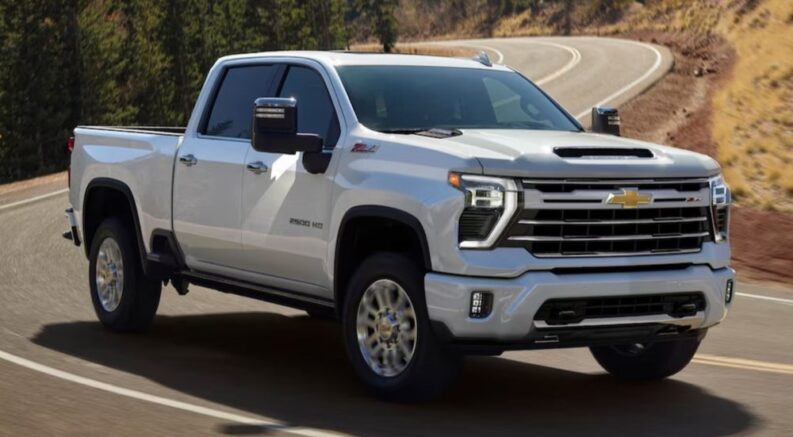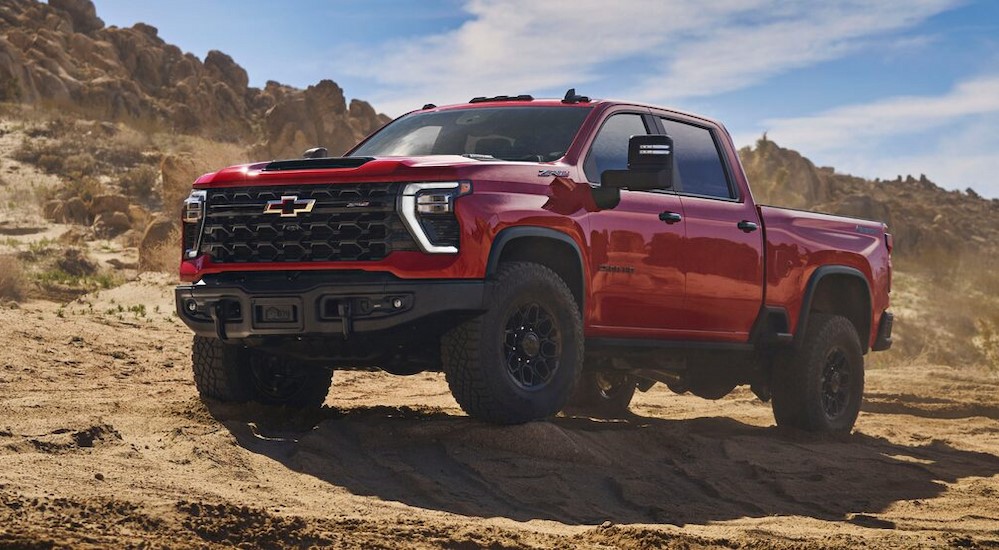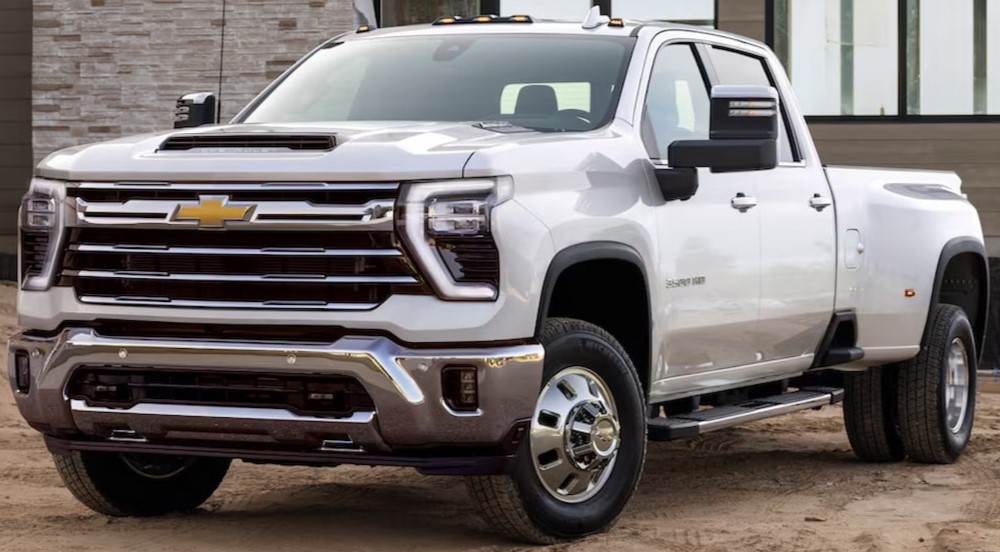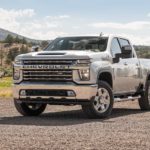As the pickup segment has grown in popularity, it’s also become a little watered down. There’s nothing wrong with the new generation of light-duty models that focus on efficiency, comfort, and luxury, but the influx of smaller trucks—especially unibody models like the Ford Maverick, Hyundai Santa Cruz, and Honda Ridgeline—threatens to dilute the segment’s reputation as a whole.
If there could only be one case to justify a heavy-duty pickup in today’s market, it would have to be the 2025 Chevy Silverado 2500 HD vs 2025 Chevy Silverado 3500 HD. Recently treated to a mid-cycle refresh that saw the Silverado HD models outfitted with new front and rear parking sensors, adaptive cruise control, a stylish Blackout package, and the new, off-road-ready Trail Boss trim, the Silverado HD models are a great example of everything there is to love about the heavy-duty segment.
Drivers have a few decisions to make when they’re in the market for a Silverado HD—specifically, which model to choose. The Silverado 2500 and 3500 both offer spacious cabins, roomy cargo beds, powerful engine options, and more than enough towing and hauling power to get the job done, but they differ in a few important ways. So, let’s see how these heavyweights stack up in direct competition…
Cab and Bed
Advantage: Silverado 2500
There’s really no one-size-fits-all solution when it comes to the pickup segment, especially when you’re talking about the cab. While some drivers might spend most of their time riding solo, others might need a roomier truck that provides additional seating for coworkers, clients, or family. The same goes for the cargo bed. If your truck is primarily going to be used for towing, the size of the cargo bed might not be that important; if, on the other hand, you’re on a first-name basis with the staff at your local lumber yard or building supply store, you might need all the cargo room Chevy can provide.
The bowtie brand boasts a wide range of cab and box styles, including Regular, Double, and Crew Cabs, which can be paired with both Standard and Long Beds, depending on the configuration. Some of these terms might be a bit misleading for those who aren’t fluent in Chevy-speak, but the differences are pretty simple once you read the fine print. The Silverado’s Regular Cab seats three passengers, while the Double Cab and Crew Cab can typically fit six. The exception is the Crew Cab with the Standard Bed, which shaves off one seat for a total capacity of five.
The biggest contrast between the Double and Crew Cabs comes down to comfort. The smaller Double Cab has a slightly cozier second row with slightly less head and shoulder room than the Crew Cab. In terms of legroom, the Crew Cab offers an additional eight inches of real estate, which might be an important consideration if you spend a lot of time transporting your team between job sites.
In truth, there’s only a small discrepancy between the two models in terms of their cabs and beds. While the Silverado 2500 is available with a Double Cab/Standard Bed, the same can’t be said for the Silverado 3500. That’s not to say there aren’t plenty of options for a driver who has their heart set on a Silverado 3500; the Double Cab/Long Bed and Crew Cab/Long Bed configurations both provide seating for up to six while providing a cargo bed that’s 16 inches longer than the one found in the Double Cab/Standard Bed.
Engine Options
Advantage: Draw
It’s tough to pick a winner when comparing the Silverado 2500 and 3500 on their engines alone. Pop the hood on both models, and you’ll either find a standard gas-powered 6.6-liter V8 engine or an available 6.6-liter Duramax turbo-diesel V8. Both of these brawny engines are paired with an Allison 10-speed automatic transmission and provide power in spades, though the turbo-diesel does have the edge in pure muscle. The gas-powered V8 is certainly no slouch with 401 hp and 464 lb-ft of torque, but it simply can’t compete with the turbo-diesel’s colossal 975 lb-ft of torque, not to mention its 470 hp. Neither model delivers much in the way of fuel economy at around 15 MPG in the city and 20 MPG on the highway, but it’s a small price to pay for that sort of mountain-moving might.
There are a few unique features that separate the Silverado 2500 and 3500 from one another. The Silverado 2500 comes standard with Chevy’s Sport Mode—a novel setting that injects a little excitement into the old workhorse; when activated, it tightens the truck’s steering, recalibrates the suspension for a more responsive ride, reduces the power steering assist, and tweaks the transmission to stay in the peak power band for just a bit longer. The result is a tight, engaging ride that’ll have you feeling like you’re behind the wheel of something much sportier than a 7,600-lb heavy-duty pickup.
Not to be outdone, the Silverado 3500 packs its own party trick in the form of the Power Take-Off (PTO) feature. Available on the WT and LT trims when opting for the 6.6-liter Duramax turbo-diesel V8, PTO gives drivers the ability to leverage the engine to power vital worksite accessories like hydraulic pumps, winches, salt spreaders, lift buckets, and more. GM was the first automaker to offer a fully-integrated PTO feature when the fourth-gen Silverados hit the market in 2020, delivering an engine-driven system that can be used even when the Silverado 3500 is idling. This engine-driven approach is a refreshing alternative to the turbine-driven systems found in other pickups, especially when it comes to noise.
Towing and Payload
Advantage: Silverado 3500
If there’s one area where heavy-duty pickups like the Silverado 2500 and 3500 have a marked advantage over their half-ton competitors, it would have to be towing and payload capacity. That’s not to say the Silverado 1500 can’t hold its own when you need to pull a trailer or accommodate a cargo bed full of construction materials (it does place toward the top of the full-size segment with an impressive 13,300-lb towing capacity), but at the end of the day, there’s simply no substitute for the kind of power that’s on tap with the Silverado 2500 and 3500.
The gulf in performance between the Silverado 1500, 2500, and 3500 comes down to four basic factors. First off, the Silverado 2500 and 3500 are built with larger, more powerful engines that put a premium on torque. In order to keep these potent powertrains running smoothly, they’re outfitted with extra hardware designed to keep the engine, oil, and transmission at the optimal temperature. These additional elements can make all the difference on longer rides, allowing the Silverado 2500 and 3500 to put in some serious work without losing their cool. The heavy-duty models also feature more robust suspension components and frames that are designed to better deal with the extreme torsion that comes with pulling a heavy load.
But how do these upgrades play out in terms of real-world numbers? We’ll start with the Silverado 2500. At the lower end of the spectrum, the traditional V8 allows this truck to pull up to 16,000 lbs when paired with RWD and the Double or Crew Cab. Introducing the turbo-diesel into the equation ups that figure to 20,000 lbs, which should be more than enough for all but the heaviest loads. Those looking to make the most of the Silverado 2500’s considerable potential should look into the Max Trailering Package, a comprehensive bundle that increases the truck’s towing capacity to 22,070 lbs when using a gooseneck hitch.
The Silverado 3500 is built of even sterner stuff with a maximum towing capacity of 36,000 lbs. Weight can start to get a little abstract when you get into that sort of territory, but to provide a little context, that’s about as much as two full-grown African bush elephants. In more relevant terms, 30,000 lbs is roughly the weight of the largest forty-foot RV. The Silverado 3500’s towing and hauling dominances come down to its unique construction. The pickup is designed with a wider chassis than the Silverado 2500 and is available with a dual-rear-wheel design that allows it to make the most of its considerable power.
The dual-wheel gas-powered V8 can tow up to 18,700 lbs, while a gooseneck hitch can accommodate 19,080 lbs. The diesel offers a 20,000-lb towing capacity with either single or dual rear wheels, but adding an extra set of tires and a gooseneck hitch represents the Silverado 3500’s most powerful iteration with 36,000 lbs of raw pulling power. The story is largely the same in terms of payload: the Silverado 2500 ranges between 3,441 and 3,689 lbs depending on configuration and equipment, while the Silverado 3500 can hold up to 7,234 lbs.
Chevy’s Heavy-Duty Clout and Capabilities
You really can’t go wrong in choosing between the Silverado 2500 and 3500, but it all comes down to how you spend your time behind the wheel. If you’ve regularly hauling livestock, pulling a boat, or are touring the country in an extra-large RV, the Silverado 3500 might be the right choice. This truck’s mammoth 36,000-lb towing capacity is about as close as you can get to driving a big rig without a commercial driver’s license, and its heavy-duty suspension, frame, and cooling elements will help to ensure safe, consistent performance for the long haul.
The Silverado 3500 does lack the Crew Cab/Standard Bed configuration, but in terms of its engine lineup and its towing and hauling capacity, it’s pretty tough to beat. The Silverado 2500 also does the nameplate proud, offering a comparable stat line and a lower starting price and operating cost due to its superior efficiency. It might be hard to pick a winner between the Silverado 2500 and 3500, but one thing is for sure: neither model is a loser.






